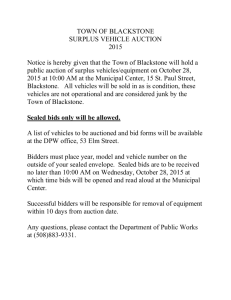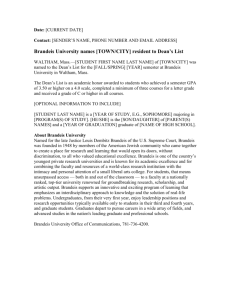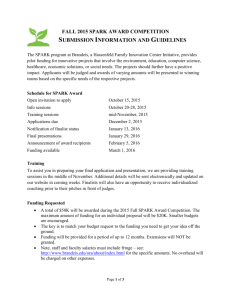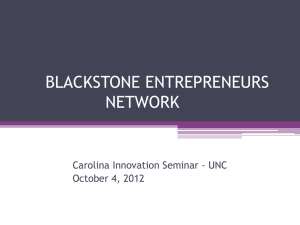Reverend William E. Blackstone - Jewish American Society for
advertisement
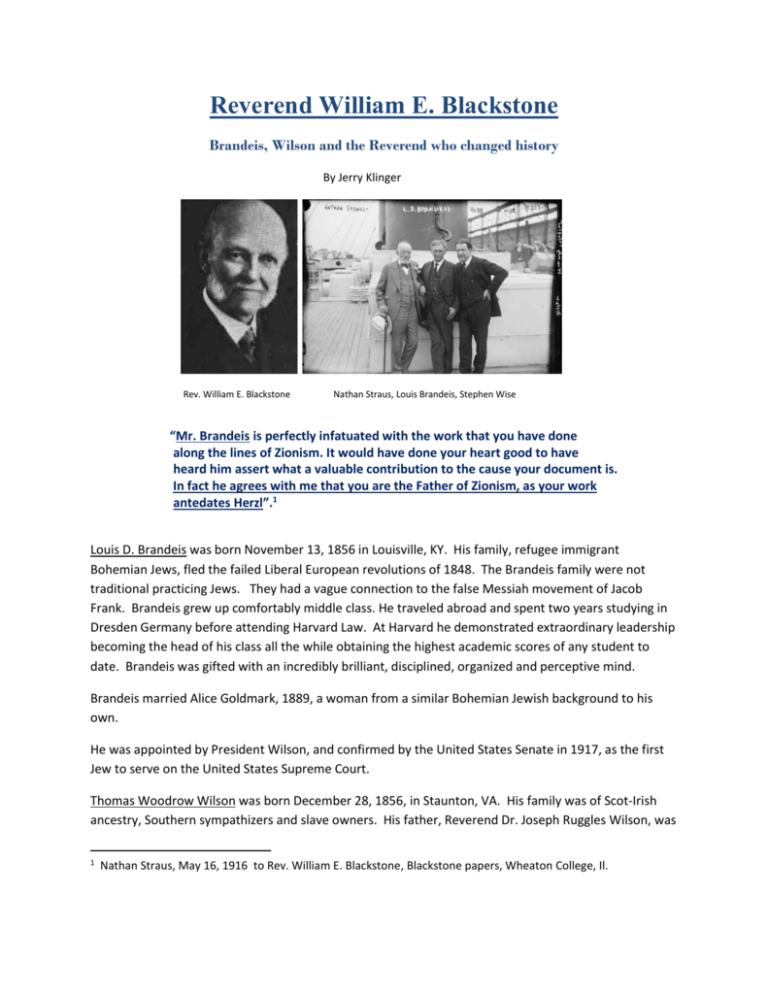
Reverend William E. Blackstone Brandeis, Wilson and the Reverend who changed history By Jerry Klinger Rev. William E. Blackstone Nathan Straus, Louis Brandeis, Stephen Wise “Mr. Brandeis is perfectly infatuated with the work that you have done along the lines of Zionism. It would have done your heart good to have heard him assert what a valuable contribution to the cause your document is. In fact he agrees with me that you are the Father of Zionism, as your work antedates Herzl”.1 Louis D. Brandeis was born November 13, 1856 in Louisville, KY. His family, refugee immigrant Bohemian Jews, fled the failed Liberal European revolutions of 1848. The Brandeis family were not traditional practicing Jews. They had a vague connection to the false Messiah movement of Jacob Frank. Brandeis grew up comfortably middle class. He traveled abroad and spent two years studying in Dresden Germany before attending Harvard Law. At Harvard he demonstrated extraordinary leadership becoming the head of his class all the while obtaining the highest academic scores of any student to date. Brandeis was gifted with an incredibly brilliant, disciplined, organized and perceptive mind. Brandeis married Alice Goldmark, 1889, a woman from a similar Bohemian Jewish background to his own. He was appointed by President Wilson, and confirmed by the United States Senate in 1917, as the first Jew to serve on the United States Supreme Court. Thomas Woodrow Wilson was born December 28, 1856, in Staunton, VA. His family was of Scot-Irish ancestry, Southern sympathizers and slave owners. His father, Reverend Dr. Joseph Ruggles Wilson, was 1 Nathan Straus, May 16, 1916 to Rev. William E. Blackstone, Blackstone papers, Wheaton College, Il. a founder and a minister of the Southern Presbyterian Church when it broke away from the mainstream Presbyterian Church in 1861. They were deeply religious people. Woodrow Wilson read the Bible and prayed daily his entire life. Wilson, unable to read until he was ten, probably suffered from dyslexia. He devised his own system of shorthand to compensate. Diligent, determined, Wilson worked hard to achieve his academic accomplishments. His family’s moderate wealth provided the means for him to graduate Princeton in 1879 and afterwards attended law school for one year at the University of Virginia. Changing majors he earned a PhD from Johns Hopkins University (1883) in history and political Science. Wilson married Ellen Axson, a minister’s daughter in 1885. She died in 1914. Woodrow Wilson had just been elected the 28th president of the United States. He remarried a year later to Edith Galt, a direct descendent of the American Indian princess Pocahontas. William Eugene Blackstone was born in Adams County, New York, October 6, 1841. His family was of very modest means. The Blackstone’s were the first white settlers of Boston. A Methodist, he accepted Jesus publically at age 11. Physically weak he was rejected by the Union army during the American Civil War but volunteered through the U.S. Christian Commission – an institution akin to the Red Cross. W.E.B., as he modestly liked to be known, was never formally educated. He was never privileged to attend University or Divinity schools. W.E.B., possessing a brilliant intellect, was largely self- educated. 1866 he married Sarah Lee Smith settling in Chicago four years later. Achieving respectable financial success as a real estate developer, he deliberately chose to abandon business and devote himself to God for the rest of his long life. * ** * * * * * * * * * * * * * * * Superficially, Reverend William E. Blackstone was a premillennial dispensational Christian evangelist and missionary. He was the author of the hugely successful and influential, Jesus is Coming, in 1878. His book, the veritable reference source of American dispensationalist thought, sold millions of copies. It was translated into 48 languages. Blackstone clearly laid out the Biblical justifications for the return of the Jews and the reestablishment of the Jewish state as a pre-condition of the second coming of Jesus. His efforts influenced countless millions of Christians to identify as Christian Zionists. Contemporary historians have almost entirely ignored, forgotten or even deliberately marginalized Blackstone’s crucial role in Zionist and American history. Anti-Zionist and pro-Palestinian sources actively remember him but with vitriol. Why? Decisions between men and their God at times come after intense introspection and struggle. For W.E.B. it was no different. A highly successful businessman, he was confronted with two paths on his life’s road. The first path was to continue in the world of Mammon making generous donations of his funds to advance his faith in God through other’s work. The second was to dedicate his life, his being, to God. In a night of deep personal struggle, filled with prayers, soul searching and painful choices, he made his choice to follow God. He pledged he would spend the next two years spreading the Gospel. The pledge was fulfilled but his two years extended to the rest of his long life. Blackstone’s Gospel was deeply influenced by John Nelson Darby and Dwight L. Moody. Perhaps the single most influential element on Blackstone’s Gospel was his self educated reading of the Bible. Since the first traumatic events of the Reformation and the translation of the Bible from Latin to the language of the layman, the Bible was open to be read by all without control and direction of clergy. It was the very freeing of access to the Bible and the fact that Blackstone never attended divinity school to shape his thoughts about his relationship to God that brought his own direct reading to Restorationism as a part of Dispensationalism. Restorationism is the belief derived from direct Biblical interpretation that one of the preconditions for the Second Coming of Jesus was the return of the Jews to their God pledged land of Palestine. Unlike 2,000 years of orthodox Catholic and Eastern Catholic thought that the Jews were replaced by the Church because of their sin of rejecting Jesus, Dispensationalist Christians believe that God had never abandoned his special relationship with the Jewish people. The Jews had endured a period of chastisement but not abandonment. Before the end of time, after periods of dispensations – the Jews would return to Palestine and rebuild the Temple. To Blackstone, God’s love for the Jewish people and their place in Biblical fulfillment of prophecy was not a revocable event of an uncertain God. Blackstone’s religious understandings linked the return of the Jews to the 1,000 year reign of Jesus in Jerusalem after the Rapture, when true believers would be called to God in safety ahead of the seven year tribulation and time of destruction that marked the end of time. Evil would be cleansed but all was dependent upon the Jews being protected to return to Palestine. Without the Jewish Restoration there could be no return of Jesus. Blackstone attended the Prophetic (Niagara) Conference of 1878. A topic of discussion was the implications of the Berlin Treaty of 1878 and the restoration of Balkan countries to their original owners. The dismemberment of the sick man of Europe, Turkey and its empire, was clearly visible. The Ottomans ruled the Holy Land for over three hundred years. Christians had comprised the largest block of people inhabiting the areas, loosely defined as Palestine, since the Byzantine Era. The conquest of the area by the Muslims in the 7th century and the forced conversions of the inhabitants changed the character of the land over time. Jewish presence, though greatly reduced in numbers, never had been severed, even since the Roman cleansing of the land of Jews. Many Christians and Blackstone clearly could read the writing on the wall. It was a matter of time. Ottoman rule over the Holy Land was coming to an end. The 19th century was an age of rediscovery of the Holy Land for many English speaking peoples. W.E.B. and his daughter visited Palestine in 1888. Americans had been engaged in physical Restorationist activity for decades in Palestine for both Christian and Jew alike. It was also the age of vicious Eastern European, and in particular Russian scapegoating, institutionalized anti-Semitism, to cover the intentional reactionism and oppression of the Russian people. Jewish life went from tenuous in Russia to questionable marginal survival in the last quarter of the century. W.E.B. was alarmed at the destruction of the Jewish people. Many in the Western media were horrified. They did little but protest in their papers. On his own, using his own funds and the incredible energy of faith and purpose, building upon his extraordinary effort to find a rapprochement of understanding of communities of faith between Christian and Jew in Chicago in 1890, Blackstone did something about Jewish suffering in Russia. November 24-25, 1890, Blackstone organized the first Ecumenical conference between Christian and Jew in America, the Conference on the Past, Present and Future of Israel. A major result of the conference was a joint, Christian and Jewish, declaration against Russian oppression of the Jews. Blackstone understood the politics of the possible. He was a man of faith but he was also a realist. America was a power rising but was not yet a world power. The Great White Fleet had not sailed. America’s destiny, as a shaper of the twentieth century, was intimated but not a reality. America was the bastion of faith in a better tomorrow but America also was not willing to become the New Zion for the world’s millions of Jews. Not even the old established, dominant, assimilated American German Jews wanted the hordes of Russian Jews, whom many of them distained, flooding onto American shores. They feared it could kindle American anti-Semitism and threaten their own hard won acceptance and toleration. Blackstone recognized the potential Russian death wish for its Jews. He linked action to save the Jews of Russia with his personal faith as “God’s Little Errand Boy”, a self described role. He sought a solution to the terrible suffering of Russian Jewry. The written resolution alone that came from the conference would not solve the problem. It was only words without actions. To save the Jews of Russia, Blackstone knew there was only one solution. Restore the Jews to Palestine. The Ottoman Empire was rotting from within under debt and decay. The return of the Jews, to some sort of semi-autonomous self rule in Palestine, would benefit the Ottomans with cash compensation and provide a solution to the “Jewish Problem” of the world. Working with feverish energy, Reverend Blackstone assembled a memorial to President Harrison. The memorial was signed by 413 prominent Americans, business leaders such as J.P. Morgan, John Rockefeller, prominent Congressional leaders including William McKinley (the later American President), Thomas Reed Speaker of the House of Representatives, religious leaders, Christian and Jewish, editors and publishers of Major American print media and even the Chief Justice of U.S. Supreme Court Melville Fuller. The Memorial called for American support in concert with the world community for the creation of a humanitarian solution to the Jewish suffering in Russia. His solution, permit the Jews to return to Palestine. The Memorial was formally presented to President Harrison March 5, 1891. The Memorial was major American news for weeks. The complete text was printed in the Chicago Tribune. President Harrison received the Memorial and Reverend Blackstone formally and with solemnity. The Blackstone Memorial was recognized as politically important. Harrison could not simply shrug it off. The Memorial urged President Harrison to “consider the condition of the Israelites and their claims to Palestine as their ancient home, and to promote, in all other just and proper ways, the alleviation of their suffering condition.” President Harrison was a pragmatist. He was not a particularly religious man and recognized the limitations of American power. He pigeonholed the focus of the Memorial. Later he did support mild diplomatic efforts to the Czar to mitigate Jewish oppression. He even mentioned the sufferings of Russian Jewry in his 3rd State of the Union Address. Blackstone’s efforts continued, presenting the Memorial to President Theodore Roosevelt with even less receptivity and action. His extraordinary effort at stirring American political support through Presidential politics faded but never left his thoughts. The ability of acting and influencing the American President had seemingly faded. It was be a full twenty five years later that the Blackstone Memorial would again resurface as a factor in American Presidential consideration and American Foreign relations. Louis Dembitz Brandeis, a nationally prominent Jewish Boston lawyer accepted, for reasons still clouded in controversy and mystery, the Chairmanship of the moribund Provisional Executive Committee for Zionist Affairs in 1914. American Zionism, disorganized, fractious and impoverished could muster about 15,000 members in 1914. Brandeis embarked on a speaking tour between 1914-1915, using his personal prestige and reputation as an American Jew to reform, organize and develop popular support for the Zionist goals of self-determination and freedom for Jews in a Jewish homeland. Brandeis legitimized for millions of American Jewish immigrants, as well as first and second generation American Jews searching for an American Jewish identity, Zionist congruence with Americanism and Democracy. Jews exercised an incredible new experience – freedom and toleration. They could strive for a Jewish solution to an age old problem, the Jewish Problem, and maintain their legitimate rights as loyal American citizens. Under Brandeis’ influence the American Zionist ranks grew from nothing to over 250,000. Few speak of or even know of today the mini-Holocaust of Jews in Eastern Europe during World War I. Savaged by both sides, but especially by the Russians by 1916, Jews were being murdered by the hundreds of thousands. It was well known in the media. Jews organized special relief efforts for food, medicine, money and political support. Not much was accomplished. Brandeis was intimately involved in the effort as a Zionist to try and save Jewish lives. America was neutral and not much could be done from the American end. It was a question of time if America would be drawn into the European conflict and then, on which side? Until the early stage of World War I the center of the Zionist world was Berlin, Germany. It soon became apparent that the Zionist movement would have to relocate to a more neutral center. Disagreements existed as to where that center should be; eventually the choices became limited to Britain or the U.S. Territoriality and tension between London and New York quickly grew up. Though part of the same movement, British Zionism saw itself as the center of the world. Legitimately, Britain was at its apogee politically. The sun never set on the British Empire around the globe. American Jewry numbered in absolute count the vastly superior population but Britain was on the ground in Europe and the Middle East fighting the Turk and the German. British Zionism was under the able leadership of Chaim Weizmann. He had been cultivating British political leadership for years; Weizmann struggled forward with his goal, a British declaration in favor of a Jewish homeland. Weizmann believed in British hegemony in the Middle East. He saw Britain as the future protector of a Jewish homeland. Weizmann and Brandeis, though working at common purposes, were already beginning to exhibit contentious differences. They did not openly share information. Negotiations with the British were well along and quite delicate. Brandeis learned about Weizmann’s efforts indirectly. “Brandeis had received intimations about Weizmann’s work as early as December 1915, when he met Alfred Zimmern, then a visiting professor at the University of Wisconsin who also participated in conversations between the British Zionist and His Majesty’s Government.” 2 Brandeis understood that the British Zionists were attempting something enormous on their own. He also understood that the British needed American support even if Weizmann had not seen fit to ask Brandeis for help. Discussions within the highest ranks of Brandeis’ inner Zionist community commenced. Brandeis was the lawyer’s lawyer. He knew the answer to every question before it was even asked. He gathered all the information he could before he proceeded to his objective. He needed to be in personal direct control of every situation. He knew what he wanted and how to get there. He did not like it any other way. A close advisor and confidant to the Brandeis’s inner Zionist circle was Nathan Straus. The Straus family were influential old line assimilated German American Jews. Oscar Straus, Nathan’s brother, had been the American ambassador to the Ottoman Court under Theodore Roosevelt. More significantly, Oscar had been a signatory of the 1891 Blackstone Memorial to President Harrison. Nathan Straus brought the Blackstone Memorial effort to Brandeis. Brandeis wrote to Richard Teller Crane, private secretary to the American Secretary of State, Robert Lansing, April 21, 1916. “My Dear Mr. Crane: There has just come to my attention a copy of a memorial presented to President (Benjamin) Harrison under the date of March 5, 1891, entitled, “Palestine for the Jews,” in which the petitioners request the President and Secretary (James G.) Blaine to use their good offices with all the leading Governments of Europe “to secure the holding at an early date of an international conference to consider the conditions of the Israelites and their claims to Palestine as their ancient home, and to promote in all other just and proper ways the alleviation of their suffering conditions. The memorial originated in Chicago, and presumably with William E. Blackstone of Oak Park, Illinois. It is signed by the leading newspapers, clergymen other public men of Chicago, New York, Boston, Philadelphia, Baltimore and Washington. 2 Louis D. Brandeis, a Life, Melvin Urofsky, Random House, N.Y., 2009 pg. 516 If there is no objection, will you kindly let me know what action was taken on this petition, and let me have copies, so far as proper, of all communications in relation thereto? The document appears to me to one of great importance at the present time. And would there be any objection to my having Photostats of the memorial and other papers? Very cordially yours,”3 Crane and the State Department could not or would not be able to share any information with Brandeis. The Blackstone Memorial of 1891 had been “lost.” Brandeis by April of 1916 was intimately involved with Woodrow Wilson and his administration. Wilson intended to nominate Brandeis as the first Jewish American to serve on the U.S. Supreme Court. Brandeis was deeply involved with the politics of nomination. His nomination was very controversial and opposed energetically, even bitterly. Eventually, by the summer of 1916, Brandeis was confirmed by the U.S. Senate in a vote along party lines. Yet in spite of the horrific strains on Brandeis’ time, energy and focus, Brandeis continued to devote himself to the Zionist cause. Unable to secure any supportive information from the State Department, Brandeis on his own, independently spent hours researching secondary and news media sources for information on the Blackstone Memorial. Amongst the Brandeis papers are 47 pages of personal hand written and researched documents confirming Brandeis’ perception of the importance of the Blackstone Memorial. That Brandeis would devote so much time and personal effort to researching and understanding the Blackstone Memorial cannot be understated. May 8, 1916, Brandeis had Nathan Straus contact Reverend Blackstone. “Mr. Brandeis is perfectly infatuated with the work that you have done along the lines of Zionism. It would have done your heart good to have heard him assert what a valuable contribution to the cause your document is. In fact he agrees with me that you are the Father of Zionism, as your work antedates Herzl”. Brandeis was a not a sycophant. He recognized what was truthful and accurate and had that information conveyed to Blackstone in the initial contact by Nathan Straus. What was incredible was that Brandeis, the head of the American Zionist movement acknowledged that Reverend William E. Blackstone, a dispensationalist Christian, was the father of Zionism. He said as his (Blackstone’s) work and ideas predated Theodor Herzl by nearly six years. Blackstone responded enthusiastically, immediately. It was the opportunity he was waiting for. He had deliberately returned from China where for years (1909-1914) he had been engaged in missionary work. Blackstone sensed that with the outbreak of World War I, Ottoman rule over the Holy Land was nearing an end, prophecy was unfolding. He wanted to be back in America, to be present to support in any way possible the Biblical future he envisioned – the Restoration of the Jews. 3 Brandeis Mss, Z 20-3) Brandeis wrote to Blackstone in Los Angeles, under official letterhead of the Provisional Executive Committee for General Zionist Affairs, office of the Chairman, May 22, 1916. Blackstone had been asked to update and represent the Blackstone Memorial to President Wilson. “My dear Mr. Blackstone: I am very glad to know from your letter of the 15th of the Memorial which you are preparing to present to President Wilson, reviving the Memorial which you presented to President Harrison twenty-five years ago. That document, ante-dating as it did Theodore Herzl’s own participation in the Zionist movement, is destined to become of historical significance: and I trust that you may be as successful in securing support for this new Memorial as you were a quarter of a century ago. In view of the work being directly undertaken by the Jewish Zionist organization, your memorial would presumably be most effective if it derives its support from non-Jews. I hope you will keep me fully informed of the progress that you are making, and will advise me in advance when you are purposing to present the Memorial, so that we may give such aid as may be possible in rendering it effective. With best wishes, Very cordially yours, Louis D. Brandeis”4 With characteristic zeal and fortitude, Blackstone revived the Blackstone Memorial within less than two months. Because of the immediacy of the moment, Blackstone elected to not obtain hundreds of individual signatories but instead focused on organizations and church support. Most importantly, he secured the endorsement o f the Presbyterian Church. It was not an accident or convenience. Wilson was a Presbyterian. Blackstone knew from his interactions with Brandeis of the political importance of the revived Blackstone Memorial. He, like Brandeis, understood the intended focus of the Memorial - the President of the United States, Woodrow Wilson. Wilson was a religious man who was raised on the Bible. He read scriptures daily and prayed for guidance and personal need daily. His first wife had been the daughter of a minister. God, the Bible and the place of Israel in Restoration were part of his conscious background. Brandeis knew and understood Wilson. He understood what influences Wilson would respond to. He understood the soul of President Wilson. Brandeis was a master politician and courtroom manipulator of opinion and direction. Wilson needed to be appealed to on the basis of faith but not by faith alone would the President act. Wilson needed to be sure of his political base of popular 4 Brandeis Mss support for his actions. He needed to be sure it was the right thing for America. He weighed his actions carefully and not impulsively. The Memorial was ready for presentation but it could not be done formally, publically. America was still neutral. The President and his advisors were very concerned that the Memorial could lead to retribution against Christian Missionaries and Jews in the areas of Ottoman control. Between 1915 -1918, Brandeis met repeatedly, even frequently, in private with Wilson. They discussed governmental issues, Zionism, Palestine, the Blackstone Memorial and the Balfour Declaration. Brandeis asked Blackstone to be patient. They had to await the best opportunity to formally present the Blackstone to President Wilson. Reverend Blackstone acquiesced to let Brandeis determine when and where the Memorial would be most effectively used. Brandeis was still hesitant a year later to present the document to Wilson. Writing to Jacob deHaas May 8, 1917, Washington, D.C. “My inclination is against presenting Blackstone petition now because of its suggestion of international guarantees. Internationalism (in) its direct application is what we have to fear most at the moment, for it would mean France and Italy in its joint control”5 Again on June 7, 1917, Brandeis still felt it was an inopportune time to present the Blackstone Memorial. Writing to Jacob deHass: “It is unwise to have any publicity re: the Blackstone Memorial at this time. “6 Reverend Blackstone was a very patient man but with his own limitation at Brandeis’s delay in presenting the Blackstone Memorial to President Wilson he took action. “June 14, 1917. “Honorable Woodrow Wilson President of the United States, Washington D.C. Dear Sir: In God’s providence, it has been my privilege to secure a remarkable endorsement of the memorial in behalf of the Jews, which is presented herewith. It, as you will note, incorporates a former Memorial 5 6 Brandeis Mss dehass May 8, 1917 Brandeis Mss. dehass June 7. 1917 of the same character, which it was my privilege to present to President Harrison, twenty-six years ago. Being unable to come to Washington at the present time, I have requested Bishop J.W. Bashford of the Methodist Church in America, and Dr. Arthur J. Browns, Secretary of the Presbyterian Board of Foreign Missions, to act as a committee for presentation of the Memorial to you. As the promoter of the memorial and representing the sentiments expressed in personal conferences with those who have endorsed it, I wish to emphasize that, because of unforeseen and changing circumstances, we all desire you, when taking action, to be guided by your best judgment as to the method or plan of accomplishing the main object asked, named to obtain relief and safety for the Jews of the world, and promote the realization of their God-given desire to be restored to their divinely appointed home Palestine. Believing that the progress of events augur the imminence of the psychological moment for benign action in behalf of the Jews, similar to that exhibited by Cyrus of Persia, and assured of your sympathy and willingness to aid the Jewish people in their present tragic sufferings, and praying that you may seize the opportunity of securing to yourself and our nation the blessing, promised by God to Abraham and his seed, by showing kindness to Israel I am most respectfully, Your obedient servant, William E. Blackstone”7 Reverend Blackstone was assured of access to the President because a signatory of the 1891 Blackstone Memorial, William E. Dodge. William Dodge was the father of Cleveland Dodge. Cleveland Dodge was Wilson’s Princeton classmate and a very close personal friend and advisor. Cleveland Dodge was one of the few personal advisors that Wilson maintained a lifelong, unencumbered, relationship with. Reverend Blackstone, William Dodge and then Cleveland Dodge, moved in the same social and religious circles. President Wilson and Cleveland Dodge shared much in their common views of philanthropy, faith and the world. Two weeks later, Rabbi Wise, “informally” met with President Wilson and presented the Blackstone Memorial. Rabbi Wise wrote to Reverend Blackstone June 30, 1917. “Rev. W.E. Blackstone, D.D., Los Angeles, Cal. Dear and Reverend Sir: I had the honor of presenting in informal fashion to the President at the White House yesterday a copy of your petition. The President accepted it, but he felt in agreement with Justice Brandeis that this was not the best time for the public or private presentation thereof. I think I have the right to 7 Zionist Archives, Jerusalem say that the President is prepared to leave to Justice Brandeis the decision with respect to the most opportune time in which formally to present the petition to him. We must therefore wait upon events and you will agree with me in permitting our friend and leader Justice Brandeis, to decide what is the most favoring hour in which to offer to the President the notable petition which you have made possible. With cordial greetings, believe me, faithfully yours, Stephen Wise”.8 Wilson knew and agreed with the Blackstone Memorial personally. Wilson was moderated by his prime concern, the pragmatic interests of America first and political exigencies second. His thinking was no doubt affirmed by his faith. “Historians of our present theme – how Woodrow Wilson was won to the Zionist cause – occupy themselves almost entirely with the story of the comings and goings of the diplomats and the courtiers….. Yet there is another element in this story which, though almost totally ignored by most of the historians, was taken with the greatest of seriousness by the Zionist principals at the time – and that is Wilson’s religious motivation. Indeed, both Louis Brandeis and Stephen Wise later said, for record, that what guaranteed the victory for the Zionists was not their greater skill in playing the political and diplomatic game, but their success in appealing to Woodrow Wilson’s biblically based Christian faith.” 9 Wilson soliloquized to Rabbi Wise during their meeting of June 30. “I am a son of the manse, son of a Presbyterian clergyman, and therefore am with you completely and am proud to think that I may in some degree help you rebuild Palestine.” 10 Wise went on during his presentation of the Blackstone Memorial to President Wilson to garb Wilson in the imagery of Cyrus the Great. Wise suggested that Cyrus’s greatness, his place in history, was recorded in Bible because he restored Israel. 11 A bit over a week later, Wise wrote Blackstone. Wise’s letter to Blackstone can be read as a rebuke for Reverend Blackstone’s approaching the President with his Memorial. Yet it also confirms that President Wilson had been aware of the 8 Zionist Archives, Jerusalem The Politics of Christian Zionism, 1891-1948, Paul C. Merkely, Frank Cass Press, London, 1998 pgs. 89-90 10 Harry S. Truman and the Founding of the State of Israel, Michael T. Benson, Praeger Publishers, 1997, pg. 19 9 11 Harry Truman commented years later about his recognition of Israel, “What do you mean "helped create"? I am Cyrus. I am Cyrus” Response to being described by his friend Eddie Jacobsen as "the man who helped create the state of Israel." (November 1953); as quoted in "With Eyes Toward Zion" (1977) by Moshe Davis Blackstone petition through Justice Brandeis. Wilson was in general agreement with the principles of the Blackstone Memorial. Wilson further understood through Brandeis that there were delicate negotiations going on in Britain for a declaration of intentions regarding Jewish interests once Britain had wrested control of Palestine from the Turks. The timing of the public release of the Blackstone Memorial was crucial. Most important for Brandeis was that Wilson understood he had significant grassroots American political and faith based support for the establishment of a Jewish homeland in Palestine. The Blackstone Memorial was an American document and not a British document. It was important for Wilson and Brandeis to show that they were not the followers of the British. American foreign policy was not shaped and directed by the British but by American interests. Reverend Blackstone wrote back to Rabbi Wise, July 9, 1917 “Dr. Stephen S. Wise 23 W. 90th Street, New York City, N.Y. Dear Dr. Wise: I have received several letters from Bishop Bashford, Mr. De Haas and Justice Brandeis in regard to the opportune time for public presentation of the Memorial to President Wilson. Also I have received your letter of June 30th in which you state, “I had the honor of presenting in informal fashion to the President at the White House yesterday a copy of your petition.” I note that the President accepted it, but wished to delay for public or even private formal presentation. As I have already written to Bishop Bashford, I am quite willing to leave the question of the most propitious time for such presentation to Justice Brandeis, as suggested in your letter. I have no personal ambition nor desires in reference to the Memorial, only that in God’s good providence, it may accomplish the best results for the Jewish people in all the world. However, I have a very firm conviction that most solemn and unprecedented events in human history are impending, and I shall not be surprised if from such delay and these events occur before the memorial is presented. “ 12 The Blackstone Memorial was never formally, publically presented to the President of the United States. Because the petition called upon the nations of the world to set up an international conference to resolve the “Jewish Problem” it ran counter to understandings the United States government had formed with the British as to control of Palestine after the war. By early September 1917, the nescient Balfour Declaration hung in the balance. It hung in the balance not on the British will but American. The British War Cabinet of Lloyd George demanded a 12 Zionist Archives, Jerusalem statement of support from the Americans before proceeding, without which the Balfour Declaration could very well fail. That statement of support came October 16, 1917 but with a condition. On October 16 the British intelligence chief in New York wired London: ''Colonel House put the formula before the President who approves of it but asks that no mention of his approval shall be made when His Majesty's Government makes formula public, as he had arranged the American Jews shall then ask him for approval, which he will publicly give here."13 Wilson had reservations about the text of the Balfour Declaration probably reflecting concerns by American Zionists that he wished to address later. Wilson did not have reservations about the intent or the purpose of the Balfour Declaration. The Balfour Declaration was issued on November 2, 1917. Weizmann wrote to congratulate Brandeis Nov. 1917: "... I need hardly say how we all rejoice in this great event and how grateful we all feel to you for the valuable and efficient help which you have lent to the cause in the critical hour ... Once more, dear Mr. Brandeis, I beg to tender to you our heartiest congratulations not only on my own behalf but also on behalf of our friends here -- and may this epoch-making be a beginning of great work for our sorely tried people and also of mankind."14 Brandeis continued to turn to Blackstone for support. . December 6, 1917, Brandeis wrote to de Haas. “Talk with Wise as to whether this would be a good time to get the Blackstone crowd to cheer?”15 August 31, 1918, President Wilson wrote to Rabbi Wise "to express the satisfaction I have felt in the progress of the Zionist movement . . since ... Great Britain’s approval of the establishment in Palestine of a national home for the Jewish people.”16 June 30, 1922, the following resolution was adopted by the United States Congress: “Favoring the establishment in Palestine of a national home for the Jewish people; Resolved by the Senate and the House of Representatives of the United States of America in Congress assembled. That the United States of America favors the establishment in Palestine of a national home for the Jewish people, it being clearly understood that nothing shall be done which should prejudice the 13 The High Walls of Jerusalem, A History of the Balfour Declaration and the Birth of the British Mandate in Palestine, Ronald Sanders, Holt, Rinehart, Winson, 1983 New York pg. 598. 14 Mason, Alphoos T.M., Brandeis, A Free Man's Life, (New York: Viking Press, 1956), p.454. 15 deHaas Mss. 16 Mason, Brandeis, A Free Man's Life, p.454. civil and religious rights of Christians and all other non-Jewish communities in Palestine, and that the holy places and religious buildings and sites in Palestine shall be adequately protected.”17 At the American Zionist Conventions in Philadelphia and Los Angeles in 1919 and 1920, Reverend Blackstone was singled out for special honor and recognition for his outstanding contribution to the Zionist movement. Reverend Blackstone remained close but formal with the American Zionist movement, Justice Brandeis and Nathan Straus for the balance of his life. He continued evangelizing and spreading the Gospel of Jewish Restoration as a strong Christian American supporter of Zionism. Reverend Blackstone spent 57 years of his life writing, speaking, preaching and encouraging Zionism. He spoke out actively and aggressively against anti-Semitism focusing in particular on the hatred spread by Henry Ford in his advocacy for the Protocols of the Elders of Zion. Reverend Blackstone never lived to see the fulfillment of his dream, the establishment of the State of Israel. He died Nov. 6, 1935. He was buried, as modestly as he had lived, at Forest Lawn Cemetery in Glendale, California. His marker stone reads simply, William E. Blackstone, 1841-1935, “Jesus is Coming”, In Loving Memory. The Chicago Jewish community, in conjunction with the Jewish National Fund, raised funds to plant the William E. Blackstone forest in the Judean Hill in 1956. The Forest was dedicated by Blackstone’s son in 1961. The location of the forest is unknown today. There is little doubt that Reverend Blackstone was crucial to the Balfour Declaration. Louis Brandeis understood the importance of the Blackstone Memorial of 1891. In the middle of his confirmation fight to sit on the United States Supreme Court, Brandeis chose to spend very important personal time and energy, rediscovering and implementing the Blackstone Memorial. Brandeis understood, clearly, the decisive impact it would have on President Wilson. Brandeis understood, clearly, that the Memorial was the key to Wilson’s support of Restoration and Zionism. Brandeis used Reverend Blackstone and the Blackstone Memorial to advance Zionist goals. Reverend Blackstone used Brandeis and the Memorial to advance his religious goals. Reverend Blackstone and the Blackstone Memorial of 1891 and 1916 are almost forgotten today. Historians of American Zionism and of Louis Brandeis almost never mention Blackstone. It is, maybe, deliberate but then much of historiography is based upon opinions and assumptions construing the history with the evidence that supports that view. Recently, a major history of the life of Louis Brandeis has been published. The work has received repeated accolades by media and other academics. There is not one word about Brandeis and Blackstone in the book. Attending a lecture about the book and Justice Brandeis in Washington, D.C. by the author, I asked about Reverend Blackstone during the question and answer session. The moment the name Blackstone came up, I was cut off by the lecturer. He responded curtly, that was 17 Congressional Record, House of Representatives, June 30, 1922, pgs. 9809-9820 1891 and had nothing to do with Brandeis. I followed up immediately about Brandeis using Blackstone to manipulate Wilson for Zionism. The Professor disparaged Wilson’s faith as a cynical public response and confirmed again that Blackstone was of no import to the audience’s snickers. What conclusions can be drawn about modern historiography and the impact of Christianity on the creation of the State of Israel seems apparent. Modern historiography is uncomfortable with Fundamentalist Christianity and its support for Israel. Modern historiography is uncomfortable with Christian faith based decisions in an age of political correctness facing Islamism and Radical Islamic Fundamentalist challenges. The role and relationship of Zionism, Christianity and Faith, as factors in history, needs to be fairly and honestly considered. Jerry Klinger is President of: The Jewish American Society for Historic Preservation www.Jashp.org
